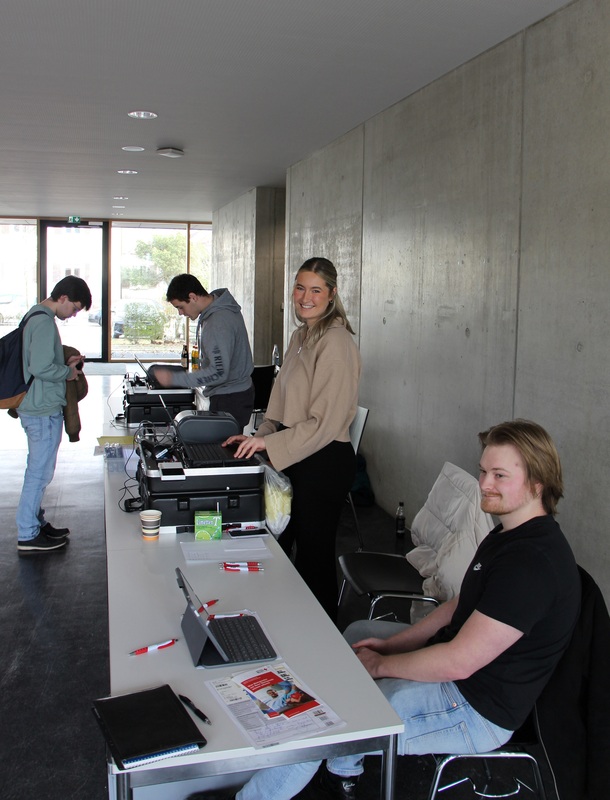With a lot of heart and soulThe Independent Student Committee of Aalen University regularly organizes blood donation campaigns

Madlien Rzany studies Healthcare Management and is involved in the Independent Student Committee of Aalen University (UStA) - like here at the registration station for blood donations. Photo: © Aalen University | Saskia Stüven-Kazi
Look or look away? Sophia Hörer prefers to look away for now. "I'm not a fan of injections at all," the young woman admits with a laugh. A quick prick and the "juice of life" begins to flow into the bag. The Business Psychology student is one of 61 blood donors that day. The Independent Student Committee of Aalen University (UStA) has been organizing blood donation campaigns at the university together with the German Red Cross for many years.
Blood is very complex
Blood is vital for the body, as it supplies it with oxygen and other vital substances from head to toe. Around five liters of blood flow through the veins of adults, and around three liters in children. Many operations, transplants or cancer treatments are not possible without sufficient blood preparations. "Although research has been going on for a long time, it is still not possible to produce blood artificially. Blood is simply very complex," says Renate Rapp. The team leader of the German Red Cross (DRK) is now working at Aalen University, where she coordinates the blood donation together with the UStA.
"A pleasant atmosphere"
How many donors has Renate Rapp already taken blood from? "I've been with the DRK blood donation team for 39 years, I can't even count all the campaigns," says the trained medical assistant and laughs heartily. But coming to the university is always something special for her. The 60-year-old lets her gaze wander through the auditorium to the various stations - from registration to the medical stations, where iron levels, blood pressure and body temperature are determined and the obligatory health questionnaire is discussed with a doctor, to the blood donation tables. "The space here is very nice and there is a pleasant atmosphere," says Rapp, adding: "Working with the many young people is simply fun."
There's a lot to manage
Around two hours earlier: the team of helpers led by Simon Hees and Madlien Rzany are already on site in the university auditorium. The 27-year-old has been involved in the UStA for some time and recently took over the blood donation department. "I'm studying Healthcare Management in my fifth semester, so of course it's a good fit," says the young woman with a smile. And there really is a lot to manage before and during a blood donation. The premises have to be organized as well as the schedule, the appointments, the purchase of drinks and food for the blood donors. Now the DRK truck with all the equipment rolls up and a hustle and bustle spreads. The eight student helpers push trolleys with bandages, couches, registration laptops and medical tents into the auditorium. Soon the entire set-up is complete and the event can begin. "The student organization team is so motivated. It's a great collaboration," says Renate Rapp happily.
"Anyone can find themselves in a situation where they are dependent on blood donations"
For many students, this is their first time donating. "You can feel the excitement a little, but that usually fades quickly," says DRK volunteer Sofia Ahmeti. It's a bit like taking blood from your family doctor, only "we draw a little more blood". And 500 milliliters to be precise. Sophia Hörer is also a first-time donor. The student is now lying relaxed on the couch and occasionally takes a look at the bag, which is gradually filling up. Why did she decide to donate blood despite her fear of injections? "To be honest? I finally wanted to know my blood group," says Hörer mischievously. "But I also think it's good for society. After all, anyone can find themselves in a situation where they need blood." One row further on, a short acoustic signal sounds: the blood bank is full and the Red Cross helper carefully pulls the needle out of the crook of Marco Bielesh's arm. "Now give it a quick squeeze, please," she says to the 22-year-old Computer Science student. A small bandage around the crook of his arm, another five-minute break, then it's on to the rest couch. Bielesh is also a first-time donor. "I'm currently doing my internship semester at Plan B in Hüttlingen, and there was recently a campaign to register for a stem cell donation. I wanted to do something good and took part," says the young man. "And when I received the university email about donating blood, I thought I could do that too."
An enrichment for university life
Meanwhile, the student helpers take care of the supply of drinks and food such as mini pizzas, butter pretzels and donuts, which get the blood donors' circulation going again. By the end of the campaign, 61 people had donated 30.5 liters of blood, saving the lives of many a sick person. Madlien Rzany and Simon Hees are satisfied: "It went really well and everyone did a great job." Rector Prof. Dr. Harald Riegel agrees. "Every semester, many students who are involved in one of the many student groups and initiatives alongside their studies - and who put their heart and soul into it - prove that life at the university is not just about learning. This enriches our university life immensely. And our society needs people who are intrinsically motivated."
Info: The UStA hopes to reach even more donors at the next blood drive and is happy about every blood donation! Volunteers are also very welcome. info@usta-aalen.de
